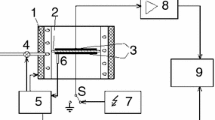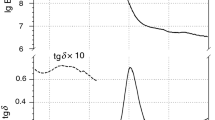Abstract
The dielectric relaxation mechanisms present in cork have been investigated in the temperature range -100 to 100 °C using the technique of thermally stimulated discharge currents. A relaxation mechanism was detected which showed a compensation behaviour as observed for the α-relaxation (or glass transition relaxation) of synthetic polymers and which lead us to attribute to cork a glass transition-like temperature of 18 °C. One lower temperature mechanism was also observed, with low activation enthalpy and entropy, which is presumably originated by local motions (internal rotations) of polar molecular groups. An upper T g relaxation of higher intensity was also detected which was attributed to large-scale non-cooperative motions of polymeric segments.
Similar content being viewed by others
References
J. V. NATIVIDADE, “Subericultura” (Ministério da Economia, Direcção dos Serviços Florestais e Agrícolas, Lisboa, 1950).
H. PEREIRA, Wood Sci. Technol. 22 (1988) 211.
P. SITTLE, Protoplasma 54 (1962) 555.
H. PEREIRA, M. E. ROSA and M. A. FORTES, Int. Assoc. Wood Anat. Bull. 8(3) (1987) 213.
M. E. ROSA and M. A. FORTES, Mater. Sci. Eng. 100 (1988) 69.
Idem, J. Mater. Sci. 23 (1988) 35.
Idem, ibid. 26 (1991) 341.
C. M. GOMES, A. C. FERNANDES and B. S. ALMEIDA, J. Coll. Interface Sci. 156 (1993) 195.
I. M. VEIGA, A. C. FERNANDES, B. S. ALMEIDA and A. J. GROSZEK, J. Mater. Sci. Lett. 12 (1993) 1206.
M. MOURGES, M. F. HARMAND, A. LAMURE and C. LACABANNE, J. Thermal Anal. 40 (1993) 863.
A. B. DIAS, J. J. MOURA RAMOS and G. WILLIAMS, Polymer, 35 (1994) 1253.
A. B. DIAS, N. T. CORREIA, J. J. MOURA RAMOS and A. C. FERNANDES, Polym. Int., 33 (1994) 293.
C. LACABANNE and D. CHATAIN, J. Polym. Sci. Polym. Phys. Ed. 11 (1973) 2315.
L. J. GIBSON and M. F. ASHBY, “Cellular Solids. Structure and Properties” (Pergamon Press, Oxford, 1988).
J. P. IBAR, Thermochim. Acta 192 (1991) 91.
J. F. MANO, J. J. MOURA RAMOS, A. C. FERNANDES and G. WILLIAMS, Polymer 35 (1994) 5171.
J. F. MANO, N. T. CORREIA, J. J. MOURA RAMOS, A. C. FERNANDES, J. Polym. Sci. Polym. Phys. Ed., in press.
D. J. PLAZEK, J. Polym. Sci. Polym. Phys. Ed. 20 (1982) 1533.
D. J. PLAZEK and G.-F. GU, ibid. 20 (1982) 1551.
J. CHEN, L. J. FETTERS and D. J. PLAZEK, ibid. 20 (1982) 1565.
S. J. ORBON and D. J. PLAZEK, ibid. 20 (1982) 1575.
R. F. BOYER, in “Computational Modelling of Polymers”, edited by J. BICERANO (Marcel Dekker, New York, 1992) pp. 1–52.
C. LACABANNE, P. GOYAUD and R. F. BOYER, J. Polym. Sci. Polym. Phys. Ed. 18 (1980) 277.
N. T. CORREIA, J. F. MANO and J. J. MOURA RAMOS, manuscript in preparation.
Author information
Authors and Affiliations
Rights and permissions
About this article
Cite this article
Mano, J.F., Correia, N.T., Moura Ramos, J.J. et al. The molecular relaxation mechanisms in cork as studied by thermally stimulated discharge currents. JOURNAL OF MATERIALS SCIENCE 30, 2035–2041 (1995). https://doi.org/10.1007/BF00353030
Received:
Accepted:
Published:
Issue Date:
DOI: https://doi.org/10.1007/BF00353030




